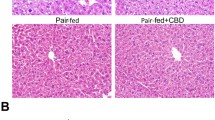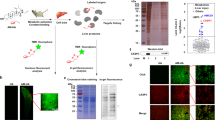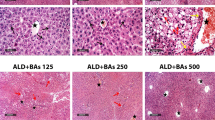Abstract
Alcoholic liver disease (ALD) is a leading cause of liver cirrhosis, liver cancer, and related mortality. The endocannabinoid system contributes to the development of chronic liver diseases, where cannabinoid receptor 2 (CB2) has been shown to have a protecting role. Thus, here, we investigated how CB2 agonism by 4′-O-methylhonokiol (MHK), a biphenyl from Magnolia grandiflora, affects chronic alcohol-induced liver fibrosis and damage in mice. A combination of alcohol (10% vol/vol) and CCl4 (1 ml/kg) was applied to C57BL/6 mice for 5 weeks. MHK (5 mg/kg) was administered daily, and liver damage assessed by serum AST and ALT levels, histology, gene, and protein expression. Endocannabinoids (ECs) and related lipid derivatives were measured by liquid chromatography and mass spectrometry (LC-MS) in liver tissues. In vitro, MHK was studied in TGFβ1-activated hepatic stellate cells (HSC). MHK treatment alleviated hepatic fibrosis, paralleled by induced expression of matrix metalloproteinases (MMP)-2, -3, -9, and -13, and downregulation of CB1 mRNA. Necrotic lesions and hepatic inflammation were moderately improved, while IL-10 mRNA increased and IFNγ, Mcl-1, JNK1, and RIPK1 normalized by MHK. Hepatic anandamide (AEA) and related N-acetylethanolamines (NAEs) were elevated in MHK group, whereas fatty acid synthase and diacylglycerol O-acyltransferase 2 expression reduced. In vitro, MHK prevented HSC activation and induced apoptosis via induction of bak1 and bcl-2. To conclude, MHK revealed hepatoprotective effects during alcohol-induced liver damage through the induction of MMPs, AEA, and NAEs and prevention of HSC activation, indicating MHK as a potent therapeutic for liver fibrosis and ALD.
Key Messages
-
Methylhonokiol improves liver damage and survival.
-
Methylhonokiol reduces hepatic fibrosis and necroinflammation.
-
Methylhonokiol prevents myofibroblast activation and induces apoptosis.
-
Methylhonokiol upregulates endocannabinoids and related N-acylethanolamines.
-
Methylhonokiol contributes to lipid hydrolysis via PPARα/γ.







Similar content being viewed by others
References
Rehm J, Samokhvalov AV, Shield KD (2013) Global burden of alcoholic liver diseases. J Hepatol 59:160–168
Burra P, Senzolo M, Adam R, Delvart V, Karam V, Germani G, Neuberger J, Elita CELT (2010) Liver transplantation for alcoholic liver disease in Europe: a study from the ELTR (European liver transplant registry). Am J Transplant 10:138–148
Addolorato G, Mirijello A, Barrio P, Gual A (2016) Treatment of alcohol use disorders in patients with alcoholic liver disease. J Hepatol 65:618–630
Tam J, Liu J, Mukhopadhyay B, Cinar R, Godlewski G, Kunos G (2011) Endocannabinoids in liver disease. Hepatology 53:346–355
Mallat A, Teixeira-Clerc F, Lotersztajn S (2013) Cannabinoid signaling and liver therapeutics. J Hepatol 59:891–896
Basu PP, Aloysius MM, Shah NJ, Brown RS Jr (2014) Review article: the endocannabinoid system in liver disease, a potential therapeutic target. Aliment Pharmacol Ther 39:790–801
Patsenker E, Stoll M, Millonig G, Agaimy A, Wissniowski T, Schneider V, Mueller S, Brenneisen R, Seitz HK, Ocker M et al (2011) Cannabinoid receptor type I modulates alcohol-induced liver fibrosis. Mol Med 17:1285–1294
Trebicka J, Racz I, Siegmund SV, Cara E, Granzow M, Schierwagen R, Klein S, Wojtalla A, Hennenberg M, Huss S et al (2011) Role of cannabinoid receptors in alcoholic hepatic injury: steatosis and fibrogenesis are increased in CB2 receptor-deficient mice and decreased in CB1 receptor knockouts. Liver Int 31:860–870
Siegmund SV (2010) Role of the endocannabinoid system in alcoholic liver disease. Dig Dis 28:751–755
Louvet A, Teixeira-Clerc F, Chobert MN, Deveaux V, Pavoine C, Zimmer A, Pecker F, Mallat A, Lotersztajn S (2011) Cannabinoid CB2 receptors protect against alcoholic liver disease by regulating Kupffer cell polarization in mice. Hepatology 54:1217–1226
Teixeira-Clerc F, Belot MP, Manin S, Deveaux V, Cadoudal T, Chobert MN, Louvet A, Zimmer A, Tordjmann T, Mallat A et al (2010) Beneficial paracrine effects of cannabinoid receptor 2 on liver injury and regeneration. Hepatology 52:1046–1059
Rajesh M, Pan H, Mukhopadhyay P, Batkai S, Osei-Hyiaman D, Hasko G, Liaudet L, Gao B, Pacher P (2007) Cannabinoid-2 receptor agonist HU-308 protects against hepatic ischemia/reperfusion injury by attenuating oxidative stress, inflammatory response, and apoptosis. J Leukoc Biol 82:1382–1389
Lee YJ, Choi DY, Choi IS, Kim KH, Kim YH, Kim HM, Lee K, Cho WG, Jung JK, Han SB et al (2012) Inhibitory effect of 4-O-methylhonokiol on lipopolysaccharide-induced neuroinflammation, amyloidogenesis and memory impairment via inhibition of nuclear factor-kappaB in vitro and in vivo models. J Neuroinflammation 9:35
Lee YJ, Lee YM, Lee CK, Jung JK, Han SB, Hong JT (2011) Therapeutic applications of compounds in the Magnolia Family. Pharmacol Ther 130:157–176
Lee YJ, Choi DY, Han SB, Kim YH, Kim KH, Hwang BY, Kang JK, Lee BJ, Oh KW, Hong JT (2012) Inhibitory effect of ethanol extract of Magnolia Officinalis on memory impairment and amyloidogenesis in a transgenic mouse model of Alzheimer's disease via regulating beta-secretase activity. Phytother Res 26:1884–1892
Bertini S, Chicca A, Arena C, Chicca S, Saccomanni G, Gertsch J, Manera C, Macchia M (2016) Synthesis and pharmacological evaluation of new biphenylic derivatives as CB2 receptor ligands. Eur J Med Chem 116:252–266
Chicca A, Gachet MS, Petrucci V, Schuehly W, Charles RP, Gertsch J (2015) 4′-O-methylhonokiol increases levels of 2-arachidonoyl glycerol in mouse brain via selective inhibition of its COX-2-mediated oxygenation. J Neuroinflammation 12:89
Kim YJ, Choi MS, Cha BY, Woo JT, Park YB, Kim SR, Jung UJ (2013) Long-term supplementation of honokiol and magnolol ameliorates body fat accumulation, insulin resistance, and adipose inflammation in high-fat fed mice. Mol Nutr Food Res 57:1988–1998
Zhang Z, Chen J, Jiang X, Wang J, Yan X, Zheng Y, Conklin DJ, Kim KS, Kim KH, Tan Y et al (2014) The magnolia bioactive constituent 4-O-methylhonokiol protects against high-fat diet-induced obesity and systemic insulin resistance in mice. Oxid Med Cell Longev 2014:965954
Wang JJ, Zhao R, Liang JC, Chen Y (2014) The antidiabetic and hepatoprotective effects of magnolol on diabetic rats induced by high-fat diet and streptozotocin. Yao Xue Xue Bao 49:476–481
Sohn EJ, Kim CS, Kim YS, Jung DH, Jang DS, Lee YM, Kim JS (2007) Effects of magnolol (5,5′-diallyl-2,2′-dihydroxybiphenyl) on diabetic nephropathy in type 2 diabetic Goto-Kakizaki rats. Life Sci 80:468–475
Sun J, Fu X, Liu Y, Wang Y, Huo B, Guo Y, Gao X, Li W, Hu X (2015) Hypoglycemic effect and mechanism of honokiol on type 2 diabetic mice. Drug Des Devel Ther 9:6327–6342
Park EJ, Zhao YZ, Kim YH, Lee BH, Sohn DH (2005) Honokiol induces apoptosis via cytochrome c release and caspase activation in activated rat hepatic stellate cells in vitro. Planta Med 71:82–84
Lee JH, Jung JY, Jang EJ, Jegal KH, Moon SY, Ku SK, Kang SH, Cho IJ, Park SJ, Lee JR et al (2015) Combination of honokiol and magnolol inhibits hepatic steatosis through AMPK-SREBP-1 c pathway. Exp Biol Med (Maywood) 240:508–518
Seo MS, Hong SW, Yeon SH, Kim YM, Um KA, Kim JH, Kim HJ, Chang KC, Park SW (2014) Magnolia Officinalis attenuates free fatty acid-induced lipogenesis via AMPK phosphorylation in hepatocytes. J Ethnopharmacol 157:140–148
Wang J, Zhang C, Zhang Z, Chen Q, Lu X, Shao M, Chen L, Yang H, Zhang F, Cheng P et al (2014) BL153 partially prevents high-fat diet induced liver damage probably via inhibition of lipid accumulation, inflammation, and oxidative stress. Oxid Med Cell Longev 2014:674690
Yin HQ, Je YT, Kim YC, Shin YK, Sung S, Lee K, Jeong GS, Kim YC, Lee BH (2009) Magnolia Officinalis reverses alcoholic fatty liver by inhibiting the maturation of sterol regulatory element-binding protein-1c. J Pharmacol Sci 109:486–495
Han XY, Hu JN, Wang Z, Wei SN, Zheng SW, Wang YP, Li W (2017) 5-HMF attenuates liver fibrosis in CCl4-plus-alcohol-induced mice by suppression of oxidative stress. J Nutr Sci Vitaminol (Tokyo) 63:35–43
Bertola A, Mathews S, Ki SH, Wang H, Gao B (2013) Mouse model of chronic and binge ethanol feeding (the NIAAA model). Nat Protoc 8:627–637
Arteel GE (2010) Animal models of alcoholic liver disease. Dig Dis 28:729–736
Schindelin J, Rueden CT, Hiner MC, Eliceiri KW (2015) The ImageJ ecosystem: an open platform for biomedical image analysis. Mol Reprod Dev 82:518–529
Lee YJ, Choi DY, Lee YK, Lee YM, Han SB, Kim YH, Kim KH, Nam SY, Lee BJ, Kang JK et al (2012) 4-O-methylhonokiol prevents memory impairment in the Tg2576 transgenic mice model of Alzheimer's disease via regulation of beta-secretase activity. J Alzheimers Dis 29:677–690
Choi IS, Lee YJ, Choi DY, Lee YK, Lee YH, Kim KH, Kim YH, Jeon YH, Kim EH, Han SB et al (2011) 4-O-methylhonokiol attenuated memory impairment through modulation of oxidative damage of enzymes involving amyloid-beta generation and accumulation in a mouse model of Alzheimer's disease. J Alzheimers Dis 27:127–141
Gertsch J, Anavi-Goffer S (2012) Methylhonokiol attenuates neuroinflammation: a role for cannabinoid receptors? J Neuroinflammation 9:135
Cho JH, Lee RH, Jeon YJ, Shin JC, Park SM, Choi NJ, Seo KS, Yoon G, Cho SS, Kim KH et al (2015) Role of transcription factor Sp1 in the 4-O-methylhonokiol-mediated apoptotic effect on oral squamous cancer cells and xenograft. Int J Biochem Cell Biol 64:287–297
Lee NJ, Oh JH, Ban JO, Shim JH, Lee HP, Jung JK, Ahn BW, Yoon DY, Han SB, Ham YW et al (2013) 4-O-methylhonokiol, a PPARgamma agonist, inhibits prostate tumour growth: p21-mediated suppression of NF-kappaB activity. Br J Pharmacol 168:1133–1145
Oh JH, Ban JO, Cho MC, Jo M, Jung JK, Ahn B, Yoon DY, Han SB, Hong JT (2012) 4-O-methylhonokiol inhibits colon tumor growth via p21-mediated suppression of NF-kappaB activity. J Nutr Biochem 23:706–715
Schuehly W, Paredes JM, Kleyer J, Huefner A, Anavi-Goffer S, Raduner S, Altmann KH, Gertsch J (2011) Mechanisms of osteoclastogenesis inhibition by a novel class of biphenyl-type cannabinoid CB(2) receptor inverse agonists. Chem Biol 18:1053–1064
Hemmann S, Graf J, Roderfeld M, Roeb E (2007) Expression of MMPs and TIMPs in liver fibrosis - a systematic review with special emphasis on anti-fibrotic strategies. J Hepatol 46:955–975
Mallat A, Teixeira-Clerc F, Deveaux V, Manin S, Lotersztajn S (2011) The endocannabinoid system as a key mediator during liver diseases: new insights and therapeutic openings. Br J Pharmacol 163:1432–1440
Pacher P, Mechoulam R (2011) Is lipid signaling through cannabinoid 2 receptors part of a protective system? Prog Lipid Res 50:193–211
Kim HS, Ryu HS, Kim JS, Kim YG, Lee HK, Jung JK, Kwak YS, Lee K, Seo SY, Yun J et al (2015) Validation of cyclooxygenase-2 as a direct anti-inflammatory target of 4-O-methylhonokiol in zymosan-induced animal models. Arch Pharm Res 38:813–825
Cusson N, Oikemus S, Kilpatrick ED, Cunningham L, Kelliher M (2002) The death domain kinase RIP protects thymocytes from tumor necrosis factor receptor type 2-induced cell death. J Exp Med 196:15–26
Roderick JE, Hermance N, Zelic M, Simmons MJ, Polykratis A, Pasparakis M, Kelliher MA (2014) Hematopoietic RIPK1 deficiency results in bone marrow failure caused by apoptosis and RIPK3-mediated necroptosis. Proc Natl Acad Sci U S A 111:14436–14441
Rickard JA, O'Donnell JA, Evans JM, Lalaoui N, Poh AR, Rogers T, Vince JE, Lawlor KE, Ninnis RL, Anderton H et al (2014) RIPK1 regulates RIPK3-MLKL-driven systemic inflammation and emergency hematopoiesis. Cell 157:1175–1188
Lin C, Yon JM, Hong JT, Lee JK, Jeong J, Baek IJ, Lee BJ, Yun YW, Nam SY (2014) 4-O-methylhonokiol inhibits serious embryo anomalies caused by nicotine via modulations of oxidative stress, apoptosis, and inflammation. Birth Defects Res B Dev Reprod Toxicol 101:125–134
Lee YK, Choi IS, Ban JO, Lee HJ, Lee US, Han SB, Jung JK, Kim YH, Kim KH, Oh KW et al (2011) 4-O-methylhonokiol attenuated beta-amyloid-induced memory impairment through reduction of oxidative damages via inactivation of p38 MAP kinase. J Nutr Biochem 22:476–486
Hyun S, Kim MS, Song YS, Bak Y, Ham SY, Lee DH, Hong J, Yoon do Y (2015) Peroxisome proliferator-activated receptor-gamma agonist 4-O-methylhonokiol induces apoptosis by triggering the intrinsic apoptosis pathway and inhibiting the PI3K/Akt survival pathway in SiHa human cervical cancer cells. J Microbiol Biotechnol 25:334–342
Abd El-Haleim EA, Bahgat AK, Saleh S (2016) Effects of combined PPAR-gamma and PPAR-alpha agonist therapy on fructose induced NASH in rats: modulation of gene expression. Eur J Pharmacol 773:59–70
Yu HE, Oh SJ, Ryu JK, Kang JS, Hong JT, Jung JK, Han SB, Seo SY, Kim YH, Park SK et al (2014) Pharmacokinetics and metabolism of 4-O-methylhonokiol in rats. Phytother Res 28:568–578
Acknowledgments
We would like to thank Philip Kellmann (Department of Clinical Research, Hepatology, University of Bern, Switzerland) for the excellent technical assistance and high performance in the in vivo part of the study. The study was funded by a grant from the Swiss Foundation for Alcohol Research to E.P.
Author information
Authors and Affiliations
Corresponding author
Ethics declarations
Animal experiments and all experimental protocols were approved by the research animal ethics committee and by the local board on animal care and experimentation of Canton Bern and were performed according to international guidelines concerning the conduct of animal experimentation.
Conflict of interest
The authors declare that they have no conflict of interests.
Electronic supplementary material
ESM 1
(PDF 188 kb)
Rights and permissions
About this article
Cite this article
Patsenker, E., Chicca, A., Petrucci, V. et al. 4-O′-methylhonokiol protects from alcohol/carbon tetrachloride-induced liver injury in mice. J Mol Med 95, 1077–1089 (2017). https://doi.org/10.1007/s00109-017-1556-y
Received:
Revised:
Accepted:
Published:
Issue Date:
DOI: https://doi.org/10.1007/s00109-017-1556-y




